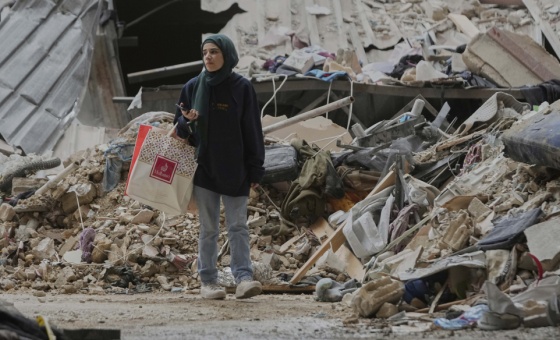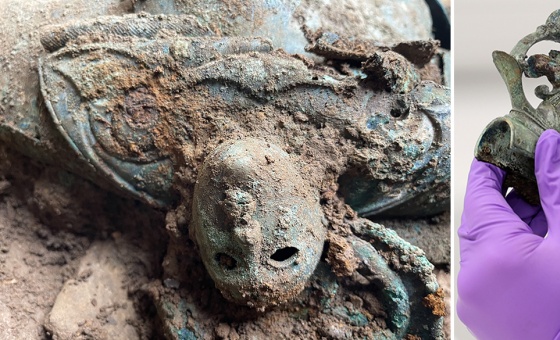This is the last article you can read this month
You can read more article this month
You can read more articles this month
Sorry your limit is up for this month
Reset on:
Please help support the Morning Star by subscribing here
WITH regional arms races and provocative military activities spiralling in east Asia, Nato chief Jens Stoltenburg’s recent visits to South Korea and Japan aimed to follow through on the organisation’s new commitment to addressing the “systemic competition” from China.
What is taking place is a historic restructuring of the international security order: amid claims that “east Asia is the next Ukraine,” Japan is resuming its role as a military power while the US-Japan 70-year-old alliance is being upgraded as the US places a primary focus on the need to contain China.
Britain is playing a vital role in leveraging this shift, building a new security co-operation with Japan which opens the door to international recognition of the country’s remilitarisation.
An innocuously named UK-Japan Reciprocal Access Agreement (RAA) signed in January in fact gives shape to a new global axis stretching from West to East — co-operation between Britain, the key transatlantic US ally, and Japan, the key transpacific US ally, now concretely links the security of the Euro-Atlantic and the Indo-Pacific in line with the 2022 Nato Strategic Concept.
The aim is to capture Eurasia in the grip of a global Nato, providing a military counter to China’s Belt and Road Initiative so as to contain the growing multipolar trend.
The RAA has followed hard on the heels of a new partnership with Japan and Italy — the Global Combat Air Programme (GCAP) — to deliver next-generation combat fighter jets.
For Britain, the deals cement global Britain’s Indo-Pacific tilt; for Japan, they bolster the most radical overhaul in its regional positioning since WWII.
Its new National Security Strategy, describing China as “the greatest strategic challenge” Japan has ever faced, is backed with a vastly increased war fighting commitment and a military budget to expand from some $50 billion to $318bn over five years making Japan the third or fourth-largest military power in the world.
Even as the Biden administration pushes at China’s red lines to provoke it into using force first, Japan seeks to align itself closer into US plans for the defence of Taiwan. This is the context in which the RAA now permits British forces to be deployed in Japan.
The RAA and GCAP are designed to sit alongside Aukus. With Britain, US and Australia all now having access agreements, few barriers remain for Japan to join this “Asian Nato” pact.
And as the first European country to forge military links with Japan, Britain provides an example for other Nato members to follow.
Britain and Japan deepened military co-operation with the visit of the Queen Elizabeth carrier strike group in 2021. In November 2022, a Vigilant Isles 22 joint exercise simulated the retaking of an island under enemy control.
With the RAA set to regularise such exercises in “island defence,” alarm bells should be ringing — to be clear: this means potentially bringing British forces into direct conflict with China given the deepening Sino-Japanese dispute over islands in the East China Sea.
These uninhabited islands — known by the Chinese (and Taiwanese) as the Diaoyutai and the Japanese as the Senkaku Islands — are coming under increased militarised patrol not only by Japanese and Chinese but also by US forces.
Lying 100 miles to the north of Taiwan and less than 300 miles from the massive US airbase in Okinawa, they would be critically important in the event of a Chinese blockade of Taiwan.
To defeat such a move the US would need a coalition of forces and it appears that Britain, alongside Japan, has just joined this.
GCAP with its high-tech programme for unmanned aircraft and cutting-edge weapons, is declared to “harness the strength of our world-beating defence industry” as part of an “unprecedented international aerospace coalition.”
BAE Systems, Rolls-Royce and MBDA will work together with Leopard in Italy and Mitsubishi in Japan to build a new fighter jet, the Tempest, to replace the Typhoon aircraft by the mid-2030s.
The Tempest’s capacity to carry hypersonic missiles will significantly increase Japan’s capabilities in joining a US war with China.
The government has committed an initial £2bn, claiming GCAP will create high-skilled jobs, strengthen our industrial base and drive innovation, opening markets in both Europe and Asia.
PricewaterhouseCoopers calculates the programme could support some 21,000 jobs a year and contribute an estimated £26.2bn to the economy by 2050.
Rishi Sunak’s new mantra — creating jobs, saving lives — now follows the US in tying future prosperity in to military development: arms manufacture and arms exports.
The US perceives the “security threats of the future” — China — to be of such an order as to demand an entirely new response, not only for all allies to pull together but also for a fusing of economic and technological resources into the structure of military pacts and alliances.
But the UK-Japan deals, along with Aukus, can only add further to the destabilisation of a region vital to the world’s future prosperity and the battle against climate catastrophe.
It is hard to ignore Britain’s choice of GCAP partners given both Japan’s and Italy’s dark past. Other Asian nations, whose memories of Japan’s WWII brutality and military-colonial occupations live on, may be far more wary of the country’s rearmament.
US progress after WWII on democratising and demilitarising Japan ground to a halt after the CPC victory in China in 1949. Suspected class-A war criminals, such as the grandfather of the former prime minister, Shinzo Abe, were released from jail with help from the Liberal Democratic Party. This has held power almost continuously over the last 70 years.
As senior political figures continue to visit the Yasukuni shrine to the war dead which still memorialises those convicted of war crimes, China, the Koreas and other Asian nations remain sceptical as to the sincerity of Japan’s apologies for its past.
Yet as Sunak collaborates in restoring Mitsubishi to its former role as arms manufacturer, it did not bother him that the company’s owners are yet to meet South Korean demands for compensation for the use of forced labour in WWII — Krupp on the other hand was convicted for war crimes for employing prisoners of war in Germany.
Shockingly, Downing Street was to draw parallels between the RAA and the Anglo-Japanese alliance of 1902. Forged to counter Russia’s expansion to the east at the time, the alliance oversaw a 20-year period of Japan’s rapid military industrialisation which then drove its bloody expansion across Asia, particularly after the joint anti-Comintern pact with Nazi Germany in 1936.
Now once again, along with the US, Britain is indulging the aspirations of Japan’s right-wing leaders. Specifically, by developing counterstrike capabilities to destroy enemy missile launch bases and other military targets, the fighter jet project actively subverts Article 9 of the Japanese constitution — the peace clause — whereby the Japanese people forever renounce war and the threat or use of force as a means of settling international disputes.
As Japan prepares to host the G7 in Hiroshima in June, the mind boggles as to what new initiatives might be announced. The Japanese public, despite rising concerns over Chinese assertiveness, may yet resist tax rises to pay for the military budget increases.
But when the RAA is put before Parliament as is expected soon, will any one of our MPs speak up? Exactly how far is Britain prepared to go in aiding and abetting a US war on China?









